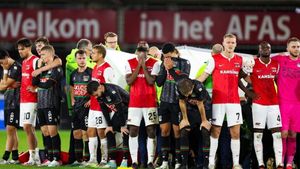On February 23, 2025, tens of thousands of supporters gathered at the Camille Chamoun Sports City Stadium in Beirut for the funeral of Hassan Nasrallah, the long-time leader of Hezbollah, who was killed nearly five months earlier by an Israeli airstrike. This mass outpouring of grief not only marked the end of Nasrallah’s three-decade leadership but also served as a pivotal moment for Hezbollah as it navigates the turmoil surrounding its existence and future.
The tragic turn of events began on September 27, 2024, when Nasrallah was killed during a targeted aerial attack by Israeli forces on Hezbollah’s headquarters located underground within residential buildings. This attack resulted not only in his untimely death but also claimed the lives of around 30 others, including many of his leaders. The airstrike left the organization reeling and highlighted its vulnerability after decades of military confrontation with Israel.
The funeral ceremony was unprecedented, with reports estimating attendance of over 55,000 people, making it one of the largest gatherings of its kind in Lebanon over the past two decades. The crowds overflowed beyond the stadium, with many supporters unable to find space inside. The atmosphere was one of solemnity and defiance, as Hezbollah leaders urged members and sympathizers to demonstrate their strength.
Among the attendees were about 800 official representatives from 65 different countries. Notable figures included Iranian Parliament Speaker Mohammad Bagher Ghalibaf and Iranian Foreign Minister Abbas Araqchi. Their presence underscored Iran’s continued support for Hezbollah and its role as the group’s principal backer.
Throughout the ceremony, which was broadcast on large screens across the city, emotions ran high. Many supporters shouted slogans against Israel, particularly during the flyover of Israeli warplanes. Israeli Defense Minister Israel Katz made it clear through social media and public statements, including, "The planes are sending a clear message: those who threaten to destroy Israel will meet their end. You will specialize in funerals, and we will specialize in victories." This statement, made shortly before the funeral, ominously framed the gathering as more than just mourning but as part of the broader geopolitical conflicts enveloping the region.
Newly appointed Hezbollah leader Naeem Qassem, who succeeded Nasrallah, pledged during the ceremony to continue on the path laid out by his predecessor. "I am faithful to the legacy of Nasrallah," Qassem declared, emphasizing the unwavering resolve of Hezbollah to maintain its agenda against Israel and to support movements such as Hamas. His comments were both reassuring for Hezbollah's base and pointed, promising retaliation and the continuation of armed resistance.
Following the Israeli airstrike on Nasrallah's bunker, Hezbollah vowed to retaliate. The losses endured have not dulled their militaristic ambitions. The ceremony featured speeches reiterative of these goals amid cries of "Death to Israel!" from those assembled, indicative of the deep-seated animosity and conflict present within Lebanese and Israeli politics.
Hezbollah remains labeled as a terrorist organization by the U.S. and several regional actors, complicity framing its activities within the narrative of global terrorism. Yet, it simultaneously serves as a political party within Lebanon, exercising significant influence and control over much of the southern regions of the country, primarily inhabited by Shiite Muslims. The complex duality of Hezbollah as both political and military makes it particularly potent and persistent as they navigate both local governance and international tensions.
Despite facing immense challenges, including the deaths of key leadership figures, coupled with the geostrategic shifts resulting from regional instability, Hezbollah's gathering at the funeral was also framed as one of resilience. Indeed, Qassem characterized the gathering as embodying this strength, highlighting the group's determination to not abandon its struggles and objectives.
International observers noted the funeral as more than merely ceremonial; it was also laden with layers of meaning related to national pride, political allegiance, and the stark realities of sectarian tensions. Each speaker and attendee reflected the dual narratives of loss and defiance, creating a charged environment reflective of the historical enmity between Hezbollah and Israel.
With the funeral of Hassan Nasrallah, Hezbollah aims to cement its narrative of defiance against outside threats, maintaining its public support and internal solidarity going forward. The potential for escalated conflict looms large as regional dynamics become increasingly complex due to the intertwining fates of conflict and governance.
Nasrallah’s death, alluded to during many speeches, marks not only the loss of one leader but may also signify future shifts within Hezbollah. How the organization adapts under Qassem’s leadership, especially with increasing Israeli military assertiveness, remains to be seen. For now, Nasrallah’s funeral sits high upon the narrative of power struggles within Lebanon and the continued war of ideologies across the Middle East.



